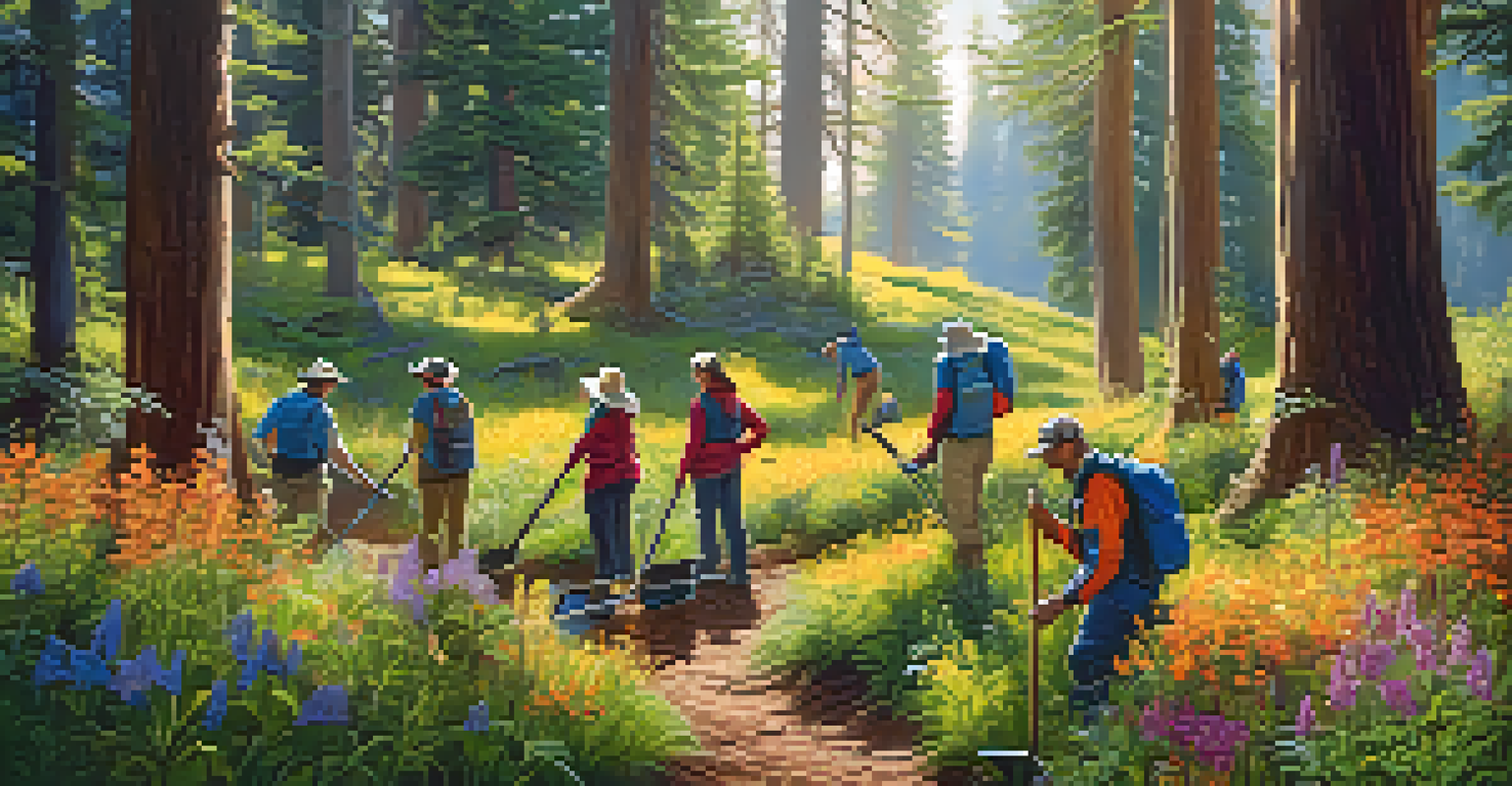Traveling to National Parks: Support Conservation Initiatives

The Importance of National Parks for Conservation
National parks play a crucial role in preserving biodiversity and natural habitats. They act as sanctuaries for countless species, some of which are endangered or threatened. By protecting these areas, we ensure that future generations can experience the beauty and wonder of nature.
In every walk with nature one receives far more than he seeks.
Moreover, national parks serve as living laboratories for scientists and researchers. They allow for the study of ecosystems and the impacts of climate change, helping us understand how to better protect our planet. These insights can guide conservation efforts both within and beyond park boundaries.
Ultimately, visiting national parks supports these vital conservation initiatives. The entrance fees and donations from visitors go directly towards maintaining and protecting these natural treasures, ensuring that they remain intact for years to come.
How Visitor Fees Aid Conservation Efforts
When you pay the entrance fee to a national park, you're not just buying a ticket; you're contributing to conservation. These fees help fund park maintenance, wildlife protection programs, and educational initiatives that foster a greater understanding of environmental stewardship.

For instance, many parks use these funds to restore habitats, remove invasive species, and conduct wildlife monitoring. This work is essential for maintaining the health of ecosystems and ensuring that native species thrive. Your visit helps make all of this possible.
National Parks Preserve Biodiversity
National parks act as vital sanctuaries for countless species and contribute to the preservation of biodiversity.
Additionally, your presence in the park encourages local economies to invest in sustainable practices. As communities recognize the economic benefits of tourism, they are more likely to support conservation efforts, creating a positive feedback loop that benefits both the environment and local residents.
Participating in Volunteer Programs
Many national parks offer volunteer programs that allow visitors to actively participate in conservation efforts. These programs can range from trail maintenance to wildlife monitoring and habitat restoration. Engaging in these activities not only helps the park but also deepens your connection to the environment.
The Earth does not belong to us: we belong to the Earth.
For example, programs like 'National Park Service Volunteer in Parks' (VIP) invite individuals to contribute their time and skills. Volunteers often gain unique insights into park operations and the challenges faced in conservation, fostering a sense of ownership and responsibility towards natural resources.
By volunteering, you can directly impact the preservation of these beautiful landscapes. Plus, it’s a fantastic way to meet like-minded individuals who share your passion for nature and sustainability.
Choosing Eco-Friendly Travel Options
Traveling to national parks offers a great opportunity to practice eco-friendly travel. Opting for sustainable transportation, such as carpooling, public transit, or even biking, reduces your carbon footprint and helps protect the environment. Every little effort counts!
In addition, consider staying in eco-friendly accommodations. Many lodges and campsites prioritize sustainability, using renewable energy sources and eco-conscious practices. By choosing these options, you support businesses that align with conservation values.
Visitor Fees Fund Conservation
Entrance fees paid by visitors directly support park maintenance and wildlife protection initiatives.
Lastly, embracing Leave No Trace principles during your visit ensures that you minimize your impact on the delicate ecosystems within the parks. Simple actions like packing out your trash and staying on marked trails contribute significantly to conservation efforts.
Educating Yourself and Others
One of the best ways to support conservation initiatives is through education. Before your trip, take the time to learn about the park’s unique ecosystems, wildlife, and conservation challenges. Understanding these aspects enhances your appreciation and encourages responsible behavior during your visit.
Sharing your knowledge with friends and family can amplify this impact. When you discuss the importance of preserving natural spaces, you inspire others to think critically about their own travel habits and the environment.
Moreover, many national parks offer ranger-led programs and workshops that provide deeper insights into conservation. Participating in these educational opportunities enriches your experience and helps you become a more informed advocate for the environment.
Supporting Local Conservation Organizations
In addition to park fees, many national parks have partnerships with local conservation organizations. These groups work tirelessly to support preservation efforts and provide resources for education and community engagement. By supporting these organizations, you're amplifying your contribution to conservation.
You can participate by donating, volunteering, or simply spreading the word about their initiatives. Many of these organizations focus on specific issues, such as wildlife protection or habitat restoration, allowing you to choose an area that resonates with you.
Eco-Friendly Travel Supports Nature
Choosing sustainable travel options and practices helps minimize environmental impact and promotes conservation efforts.
When travelers engage with these organizations, it fosters a spirit of collaboration. This partnership between visitors and local conservation efforts is vital for sustaining the beauty and integrity of national parks.
The Ripple Effect of Responsible Tourism
Responsible tourism goes beyond individual actions; it creates a ripple effect that can lead to significant change. When visitors prioritize sustainability and conservation, it sets a standard that encourages others to do the same. This collective effort can influence park policies and promote more robust conservation practices.
For example, when tourists demand eco-friendly services, businesses within and around national parks are more likely to adopt sustainable practices. This shift not only benefits the environment but also enhances the overall visitor experience, creating a win-win situation.

Ultimately, your choice to travel responsibly sends a powerful message about the importance of conservation. Each visit to a national park is not just an opportunity for adventure but also a chance to support a larger movement that prioritizes protecting our planet.
Conclusion: Be a Part of the Conservation Solution
Traveling to national parks offers an incredible opportunity to connect with nature while supporting vital conservation initiatives. By understanding the impact of your visit, you can make informed choices that contribute positively to the environment.
Whether through paying park fees, volunteering, or practicing eco-friendly travel, every action counts. Your engagement not only helps preserve these national treasures but also inspires others to join in the effort.
As you plan your next adventure, remember that you are part of a larger story: one that recognizes the importance of conservation and the beauty of the natural world. Together, we can ensure that these parks remain vibrant and thriving for generations to come.